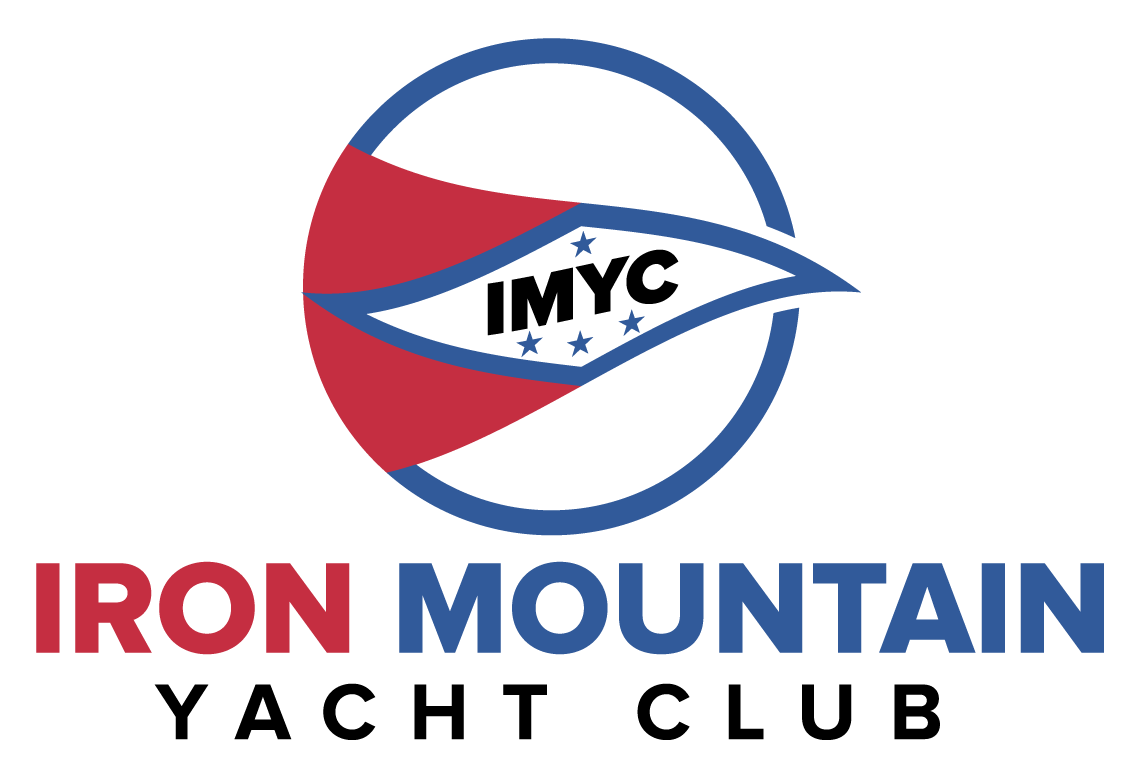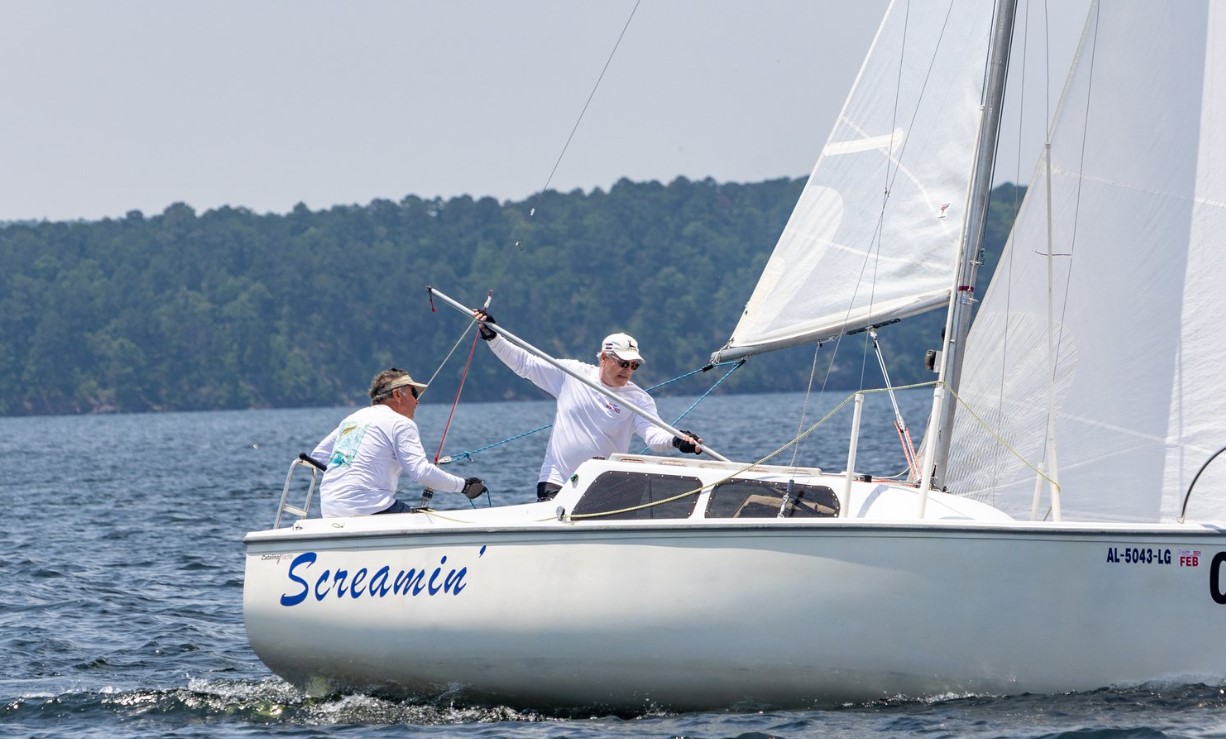What if you are a small yacht club on a Corps of Engineers lake in the middle of beautiful South Arkansas mountains, streams and forests, and despite your size and small number you volunteer to host a national championship one design regatta over five days. You know it’s a chore that will require all hands on- deck to make the regatta a success because you have hosted two previous regional regattas for the same group.
Sure enough, your offer is accepted and on the appointed day 26 boats show up, from as far away as Washington State, Minnesota and Florida. The boats are rigged and dropped in the lake, and the work of getting every boat in a slip is finished. Then the Saturday night welcoming party begins. Like racing sailors everywhere at such a gathering there is much frivolity, back slapping, and good natured ribbing. Everyone is having a great time; getting to meet new friends and reacquaint with old ones, sharing stories and the blessings of good food, fine spirits and lots of belly laughs.
And while all this is happening, a somewhat unexpected and very unwelcome guest shows up – a hugely bulbous, stationary high pressure dome – smack in the middle of the country. There is hardly a whisper of a wind. After all the hours and hours of work, planning, organization and the assigning of tasks for everyone – hoping for a great event – the wind forgets to show up. Such was the dilemma at the Iron Mountain Yacht Club on Degray Lake in mid May, near the small college town of Arkadelphia.
The Catalina 22 was the inaugural boat of the boat building company designed by the owner Frank Butler, and was first built in 1969 in North Hollywood, California. It was designed as an affordable family boat with a swing keel that was easy to load and tow, easy to rig quickly, and easy to sail. It proved so popular it launched the company and over 16,000 have now been built. Many of the first run boats are still sailing and racing. In fact, some of the earliest boats continue to do very well in the racing fleet because of their lighter overall weight.
The Catalina National Sailing Association was formed in 1970 to help promote fellowship and racing and a few years later the first California State Championship Regatta was held in Mission Bay, California with 45 boats competing. This proved so successful that both regional and national championships are held all around the country. Because of the boats affordability many of the boat’s sport beautiful and colorful paint schemes and are a delight to the eye. Manufacturing plants are now on both the east and west coast, England, Australia and Canada.
Our national regatta attracted a total of 26 boats from all over the country. Once again race officer Hal Smith headed the race committee and directed traffic on the water. He held many ‘mini seminars’ for local club volunteers who manned the various power boats that laid out the buoys and adjusted the course for the local conditions. Each day competitors were provided sack lunches and most nights an evening meal was shared by all.
The practice race on Sunday had just enough wind to complete a double windward-leeward race and last year’s national champion “Screamin” did a ‘horizon job’ on the fleet, finishing well ahead of the pack. Monday’s racing was a complete bust with no wind. Spectators saw painted sails on a shimmering painted lake with only an occasional narrow streak of light wind rippling the surface. Tuesday’s forecast was not much better but the fleet did manage to complete two races with shortened courses. As most racers know, such conditions can be very frustrating and extremely challenging and a real crap shoot as to where the next pressure will develop. Competitors also know that it takes intense concentration and a very delicate touch on the helm, along with careful movement on the boat to maintain any gained momentum. In the second race of the day, Duncan McBride in his really beautiful ‘Hoss It Up’ boat, after competing in multiple Catalina 22 events and many races, finally crossed the finish line in first place – on his birthday.
By Tuesday night some isobars began to show up on the high pressure dominating the central United States and there was optimism in the fleet when the forecast predicted winds out of the east, with speeds of 7-10 mph. With high hopes of making up some races the fleet was on the water very early on Wednesday morning. The fleet typically flies a 150 genoa up front with a whisker pole, going wing on wing downwind. Many even trying to adjust the front sail to get a lifting force out of the front sail instead of just a push.
Wednesday did not disappoint and four races were run – and best of all the wind was steady, like the wind gods had turned on a fan with gusts up to 14 mph. The Catalina 22’s love these conditions and the action on the water at times was wild and woolly, especially at the rounding marks. With such a tight knit group of competitors who are good friends, few if any protests are ever lodged in the fleet.
Going into the last day of racing a total of 6 races had been run, leaving only one final race to determine the national fleet champion. Last year’s champion Keith Bennett and his crew Doug Thome on ‘Screamin’ were once again in the lead, four points ahead of their nearest rival, “Mischief,” with Mickey Richardson and his crew. The monster high pressure that had so dominated early had finally migrated to the northeast and it looked to be a fine day for sailboat racing – sunny, low 80’s, and good wind out of the east. The jinx had been lifted.
‘Screamin’ and ‘Mischief’ were both so far ahead in scoring that the only seeming question was – could the second boat finish far enough ahead of the leader to make up the point difference and take the national championship? Both boats were in the lead pack after the start and up and down the legs they fought it out and were never more than a few boats apart. On the last downwind run it was neck and neck between the two and at the end ‘Mischief’ crossed a few seconds ahead of its rival. So, it was a moral victory for them, while Keith Bennett and crew aboard “Screamin” won the national championship.
That night at the beautiful Degray State Park Lodge during a fine meal and awards presentation there was lots of laughter and recounting of the great sailing on the last two days. Their goal of having raced seven races had been met and the regatta had been a success.
The little club that thought it could, did – having fed and hosted close to a hundred folks during the week, including Rocky and Patsy’s world famous ribs, while providing on the water help in setting up and running the course. Overall, everyone agreed, the only real losers were the ones who wanted to be there, but couldn’t.
John R. Bomar

